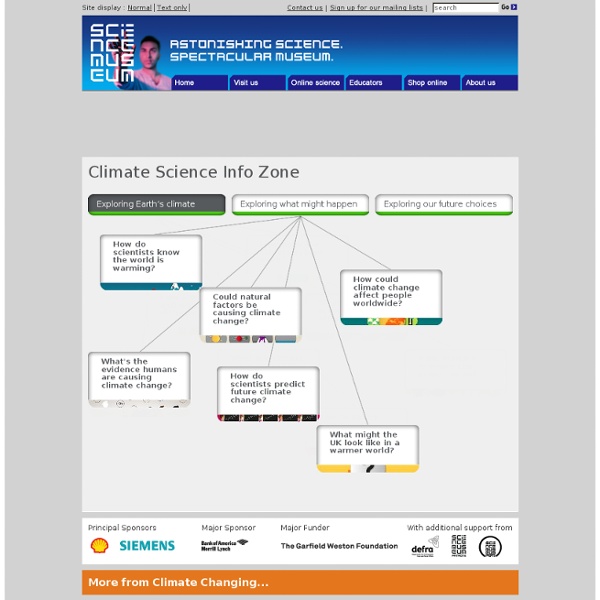A History of Climate Science
Skeptical Science takes a different approach to Naomi Oreskes' Science paper who sorted her papers into "explicit endorsement of the consensus position", "rejection of the consensus position" and everything else (neutral). In this case, the backbone of our site is our list of climate myths. Whenever a climate link is added to our database, it is matched to any relevant climate myths. Therefore, each link is assigned "skeptic", "neutral" or "proAGW" whether it confirms or refutes the climate myth. This means a skeptic paper doesn't necessarily "reject the consensus position" that humans are causing global warming. There are a large number of neutral papers. So yes, categorisation can get a little complicated and I expect there will continue to be discussion on the issue of classification.
Login to your Account
Create a free account now your Sparkol account To access your account, please enter your username (registered email address) and password Your username is your email address Enter your password Forgot Password? If you don't have a Sparkol account, you can create a free account today and can start using Sparkol. Videoscribe More Sparkol Your Account Questions, Feedback, Comments? © Copyright 2013 Sparkol Ltd.
Native Vegetation Group 16 - Heathlands
Native Vegetation Groups for Victoria home Heathlands Native Vegetation Map High resolution map of Simplified Native Vegetation Group 16 [PDF File - 707.8 KB] - includes major roads and towns. Ecological Vegetation Class Descriptions Bioregional Conservation Status and EVC benchmarks 16.1 Heathlands - Sandy and/or well drained EVC 5 Coastal Sand HeathlandAn open or closed coastal heathland dominated by a diverse shrub layer and a variable ground layer of sedges, lilies and grasses. EVC 6 Sand HeathlandTreeless heathland (or with scattered emergent mallee-form eucalypts and/or banksias) occurring on deep infertile sands. EVC 89 Dunefield HeathlandTreeless heathland or low shrubland. EVC 90 Tea-tree ScrubA dense scrub of Mallee Tea-tree Leptospermum coriaceum associated with the Outlet Creek system. Page Top 16.2 Heathlands - Not well drained EVC 7 Clay HeathlandOccurs on sites with impeded drainage, often on duplex soils. 16.3 Heathlands - Sub-alpine
TckTckTck | the Global Campaign for Climate Action
7 Web 2.0 Tools for Students
SmoothDraw SmoothDraw is an easy natural painting and digital free-hand drawing software that can produce high quality pictures. It supports many kinds of brushes (pen, pencil, dry media, airbrush, image, etc.), retouch, tools, layers, image adjustment, and many effects. This software works great with tablets and PC. It is a freeware so it is free to download. You can find the site here: Bitstrips Bitstrips is an educational tool that engages students using a medium they love, comics! You can find the site here: Archimy Is a service for drawing the graphs of all kinds of functions. You can find the site here: ChartGizmo Is a free web 2.0 tools where students can create charts for a website, blog, or social network profile. You can find the site here: The last three are probably the most important for students to use in the classroom and I am not going to include a picture for them.
Renewables: The 99.9 percent solution
A view of wind turbines from the Hrad, in Slovakia. Photo by Ricz Ribeiro/flickr. Jan. 20, 2013 Renewable energy? Too unreliable, too expensive, many people think. By Tim RadfordClimate News Network LONDON – A combination of wind and solar power and sophisticated energy storage systems could keep a power grid fully supplied between 90 and 99.9 percent of the time, at costs comparable with today's fossil fuel and nuclear mix, according to a new study from Delaware in the United States. The key is to get the right combination of electricity sources and storage. - Willett Kempton, University of Delaware Computer simulation measured the performance of inland and offshore wind farms and photovoltaic cells, backed up by battery and fuel cell storage, under the lowest cost conditions, for a 72 gigawatt grid system (one gigawatt will typically provide power for about 750,000 to a million US households).. Huge storage costs But they found quite a different result. Without subsidies
Breathingearth - CO2, birth & death rates by country, simulated real-time
360 Degree Aerial Panorama | 3D Virtual Tours Around the World | Photos of the Most Interesting Places on the Earth | AirPano.com



